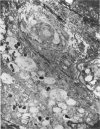Abstract
Although Mycobacterium leprae was identified earlier than Myco. tuberculosis, it has still not been cultured in vitro and only in 1960 was an infection obtained in laboratory animals. However, important advances have been made in the field of experimental leprosy in the last decade due to the development of new techniques and models for studying Myco. leprae in vivo, thus overcoming the limitations imposed by a non-cultivable mycobacterium. Quantitative techniques using Myco. lepraemurium provided the first model for developing an indirect method for distinguishing dead (non-infectious) from living (infectious) bacilli, based on morphological differences in organisms stained by the Ziehl—Neelsen method. However, the most important advances resulted from the limited and localized growth of Myco. leprae when inoculated into the foot pads of mice and, later, the more substantial and generalized multiplication of Myco. leprae in immunologically deficient mice (thymectomized and irradiated with a dose of 900 r). Moreover, in the immunologically deficient animals, the infection eventually resulted in a disease replicating that of lepromatous type leprosy in man, including the involvement of peripheral nerves.
The results from these studies and the future prospects for the study of leprosy in the laboratory are reviewed in this article.
Full text
PDF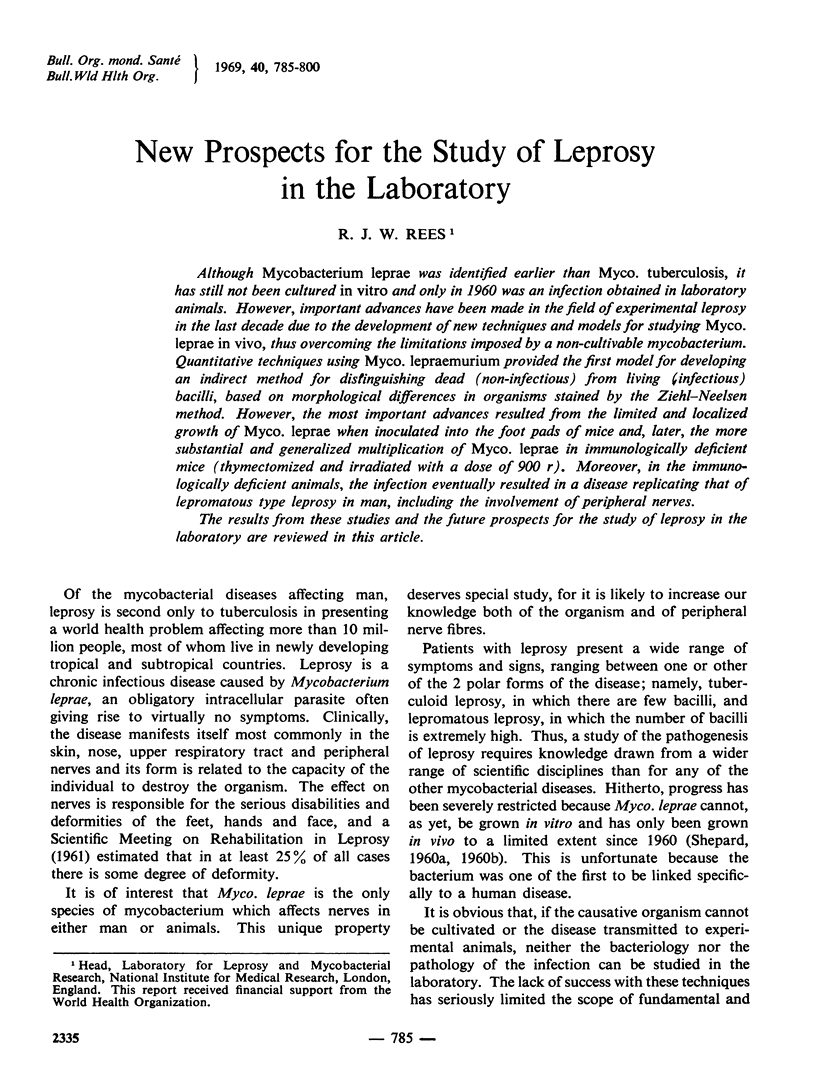
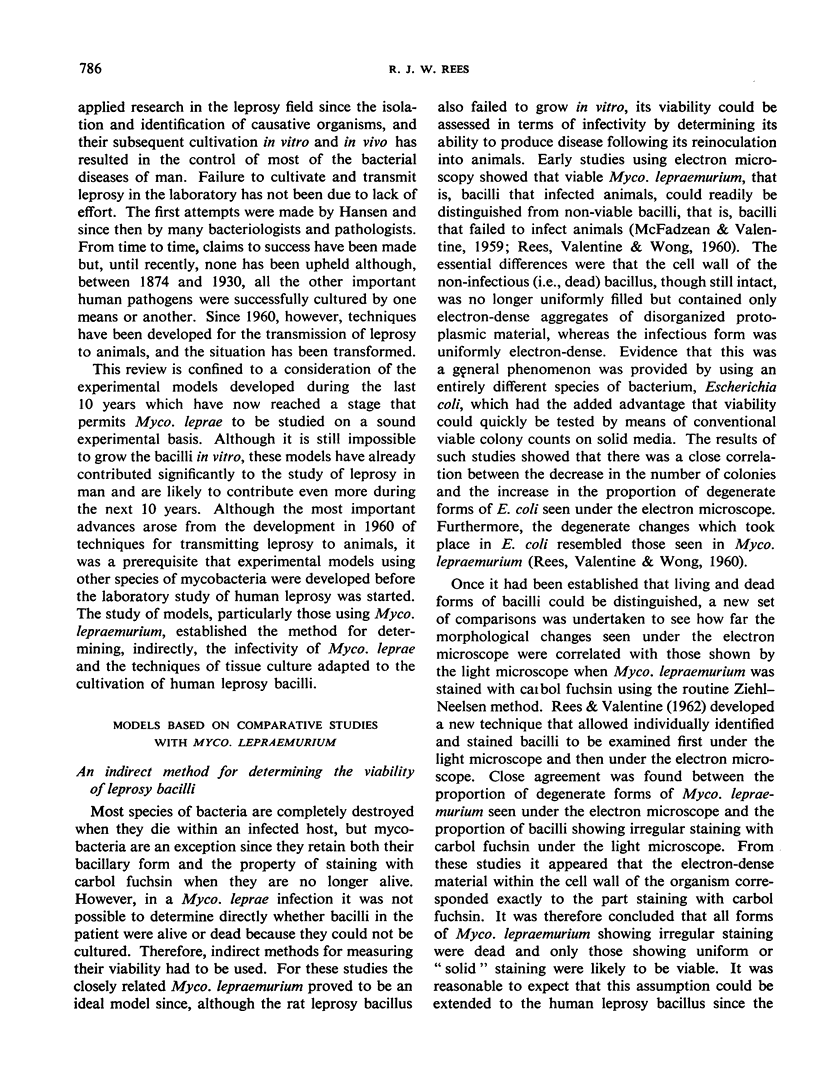
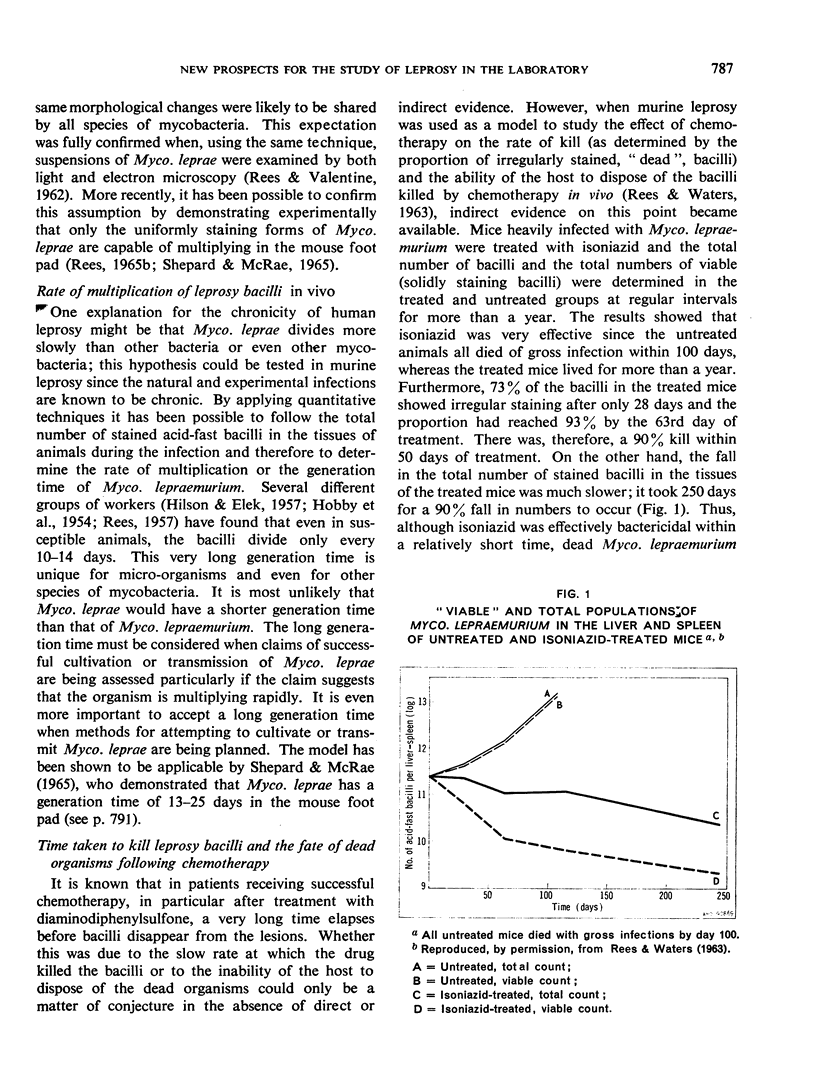
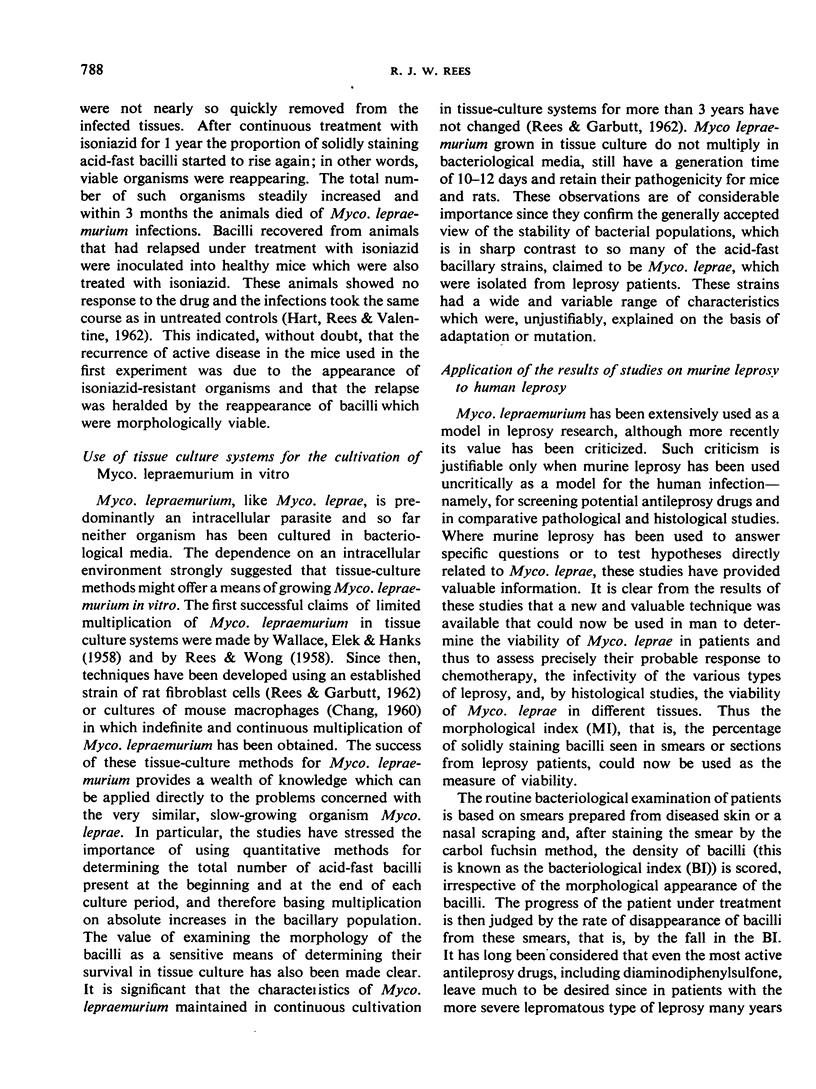
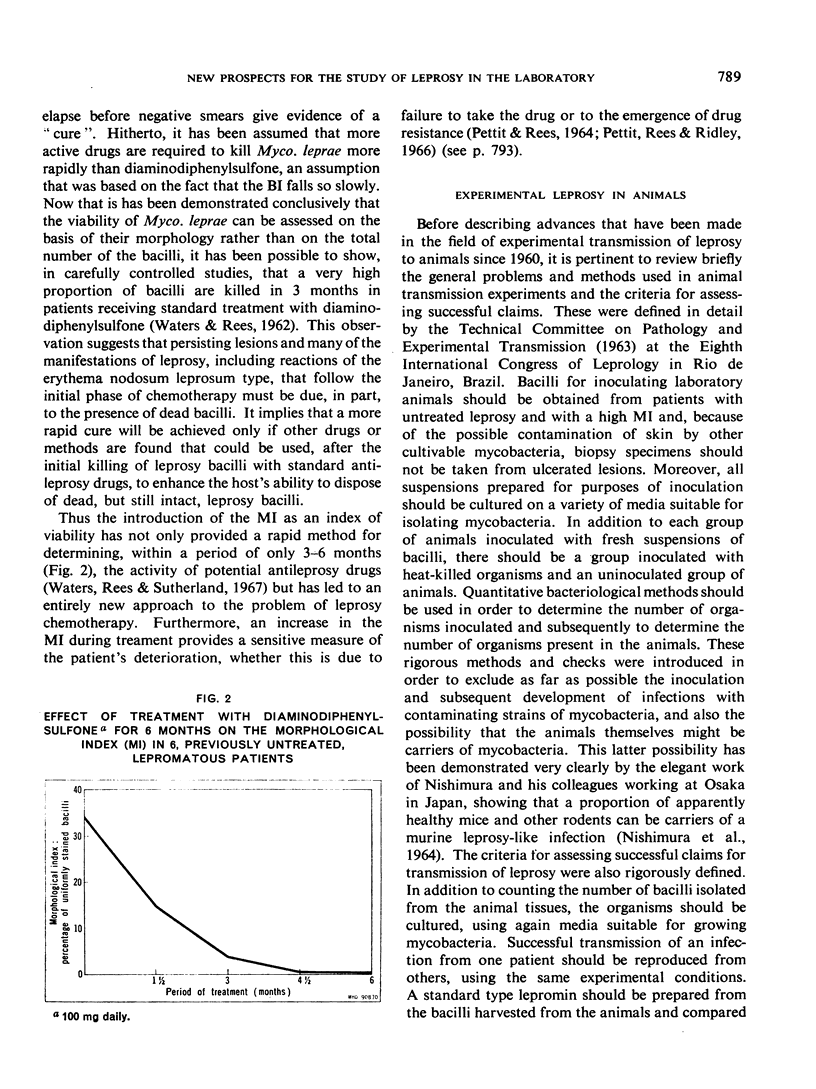
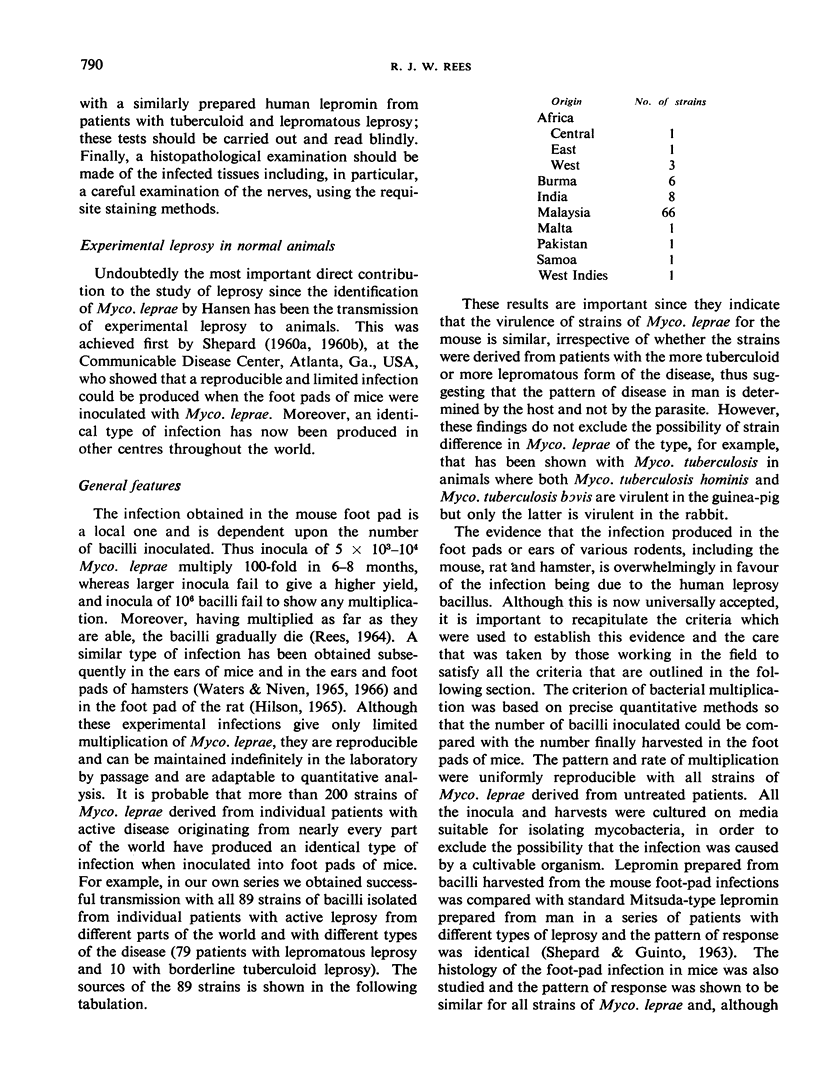
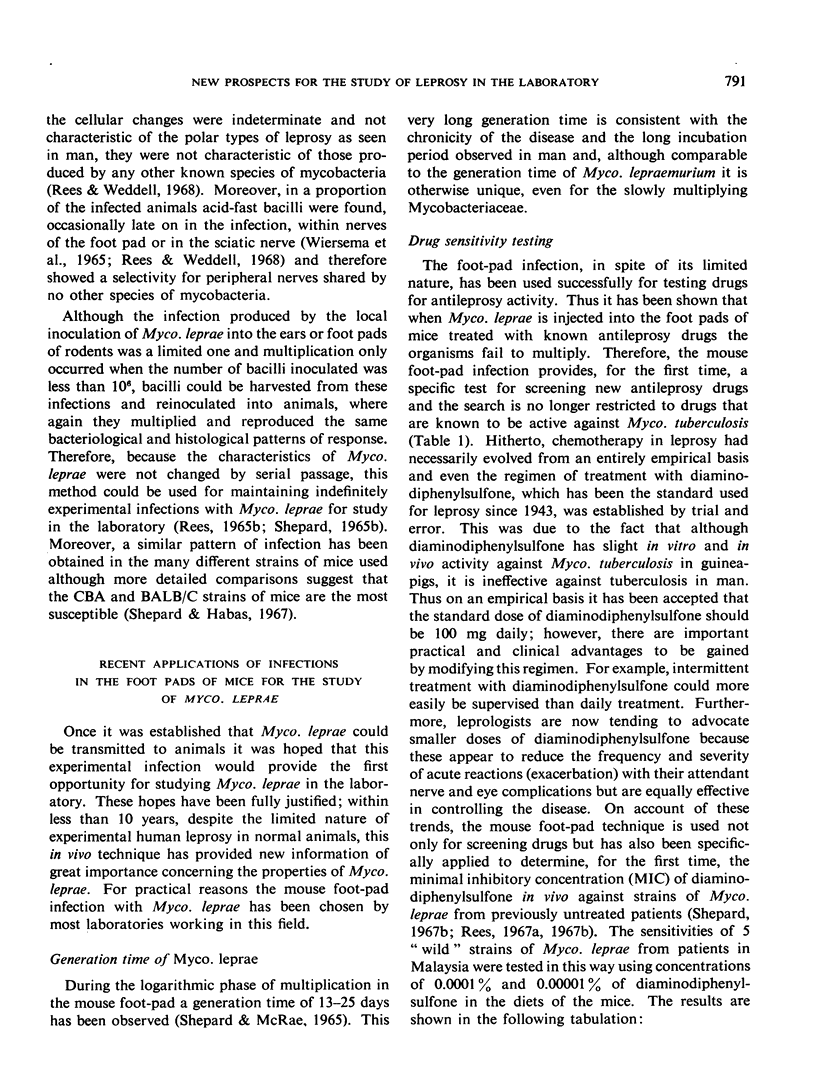
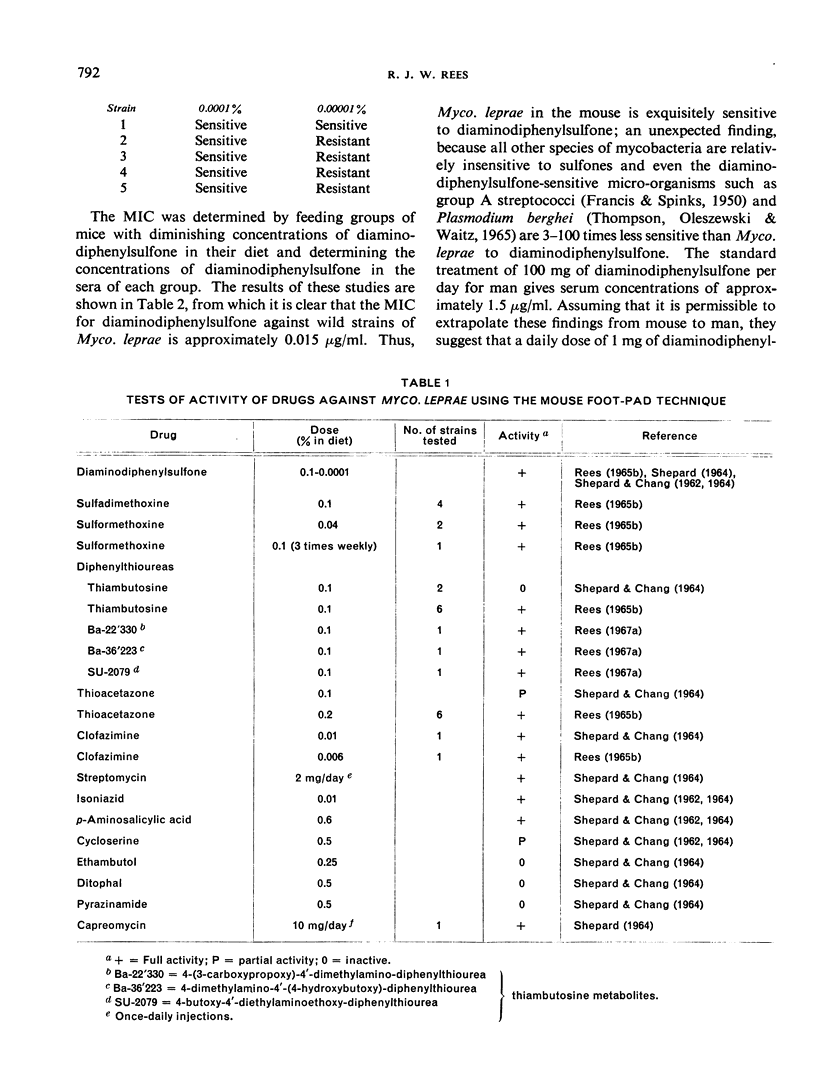
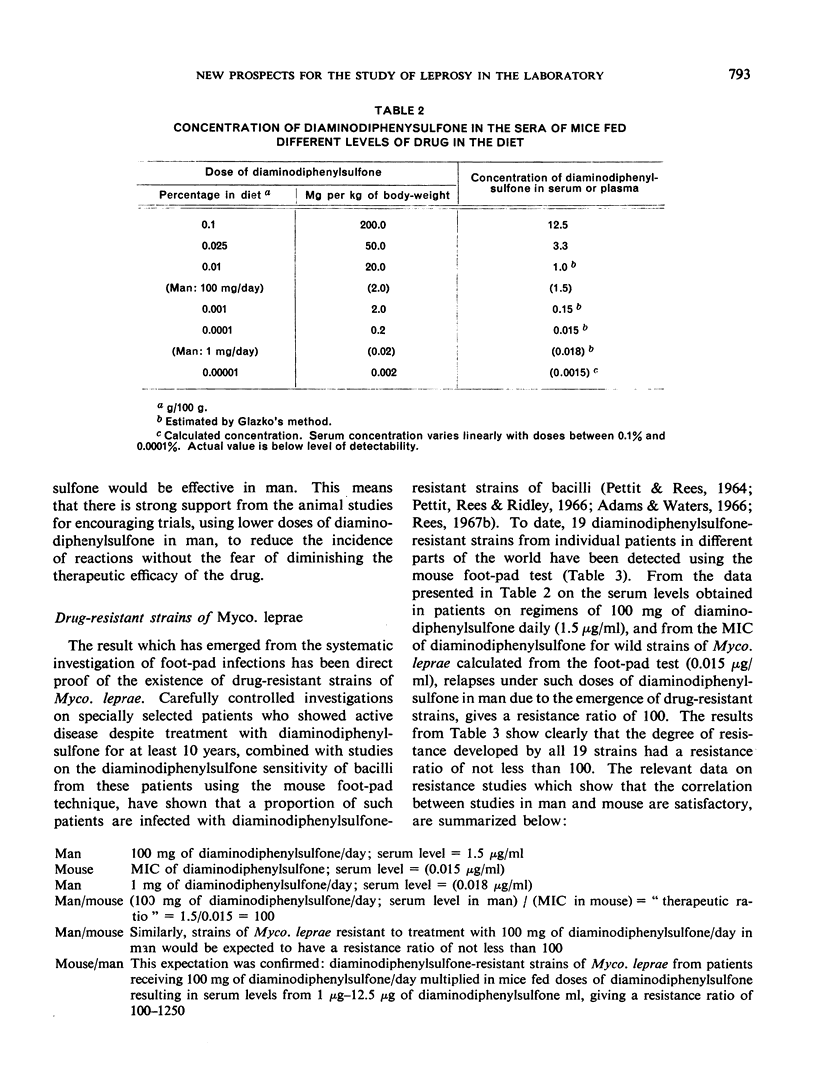
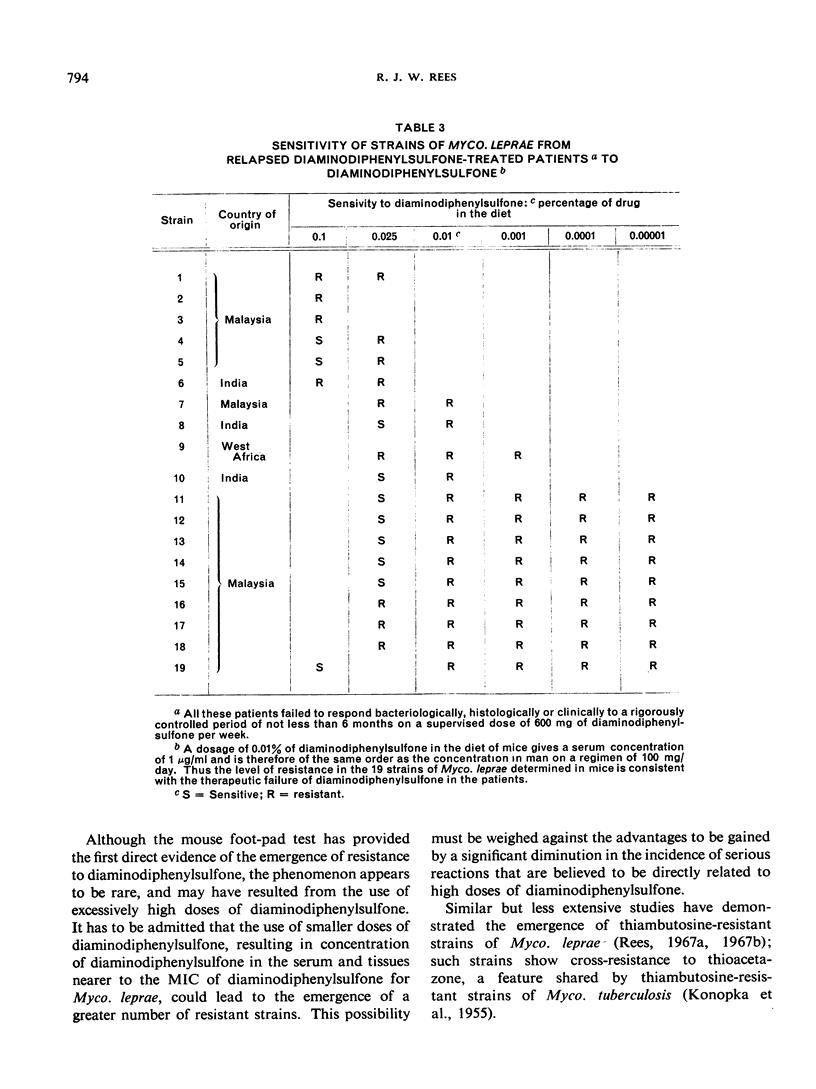
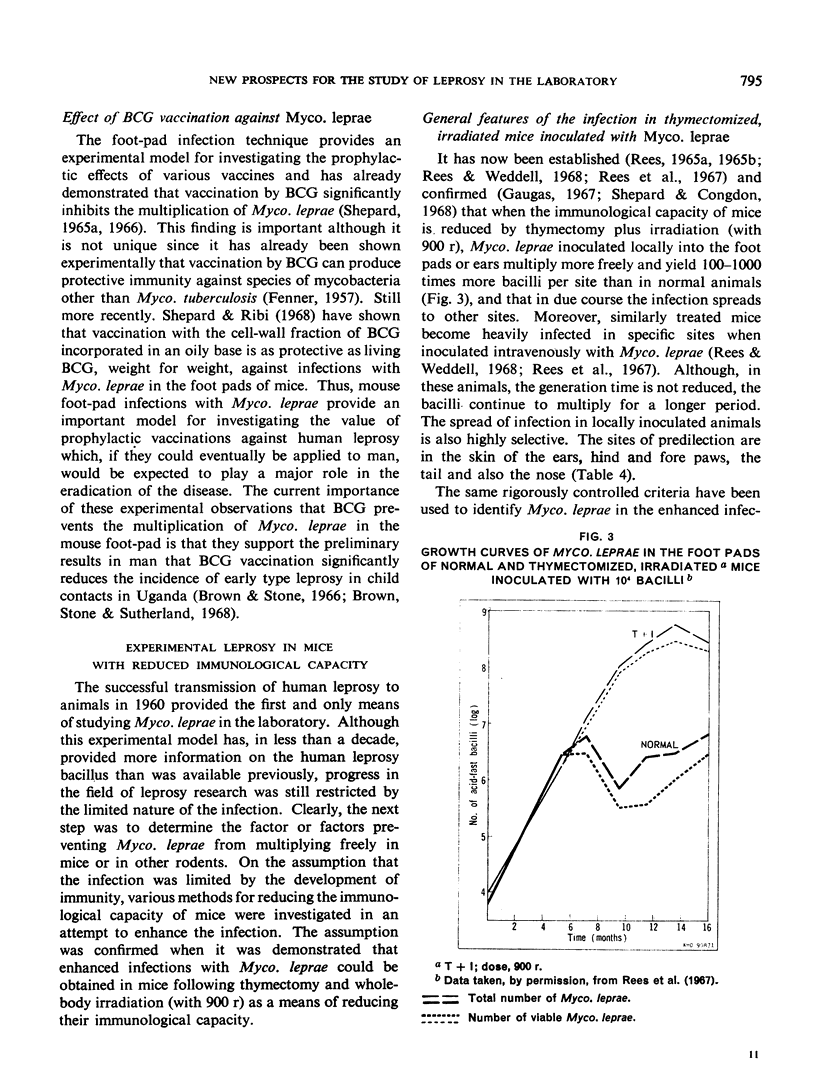
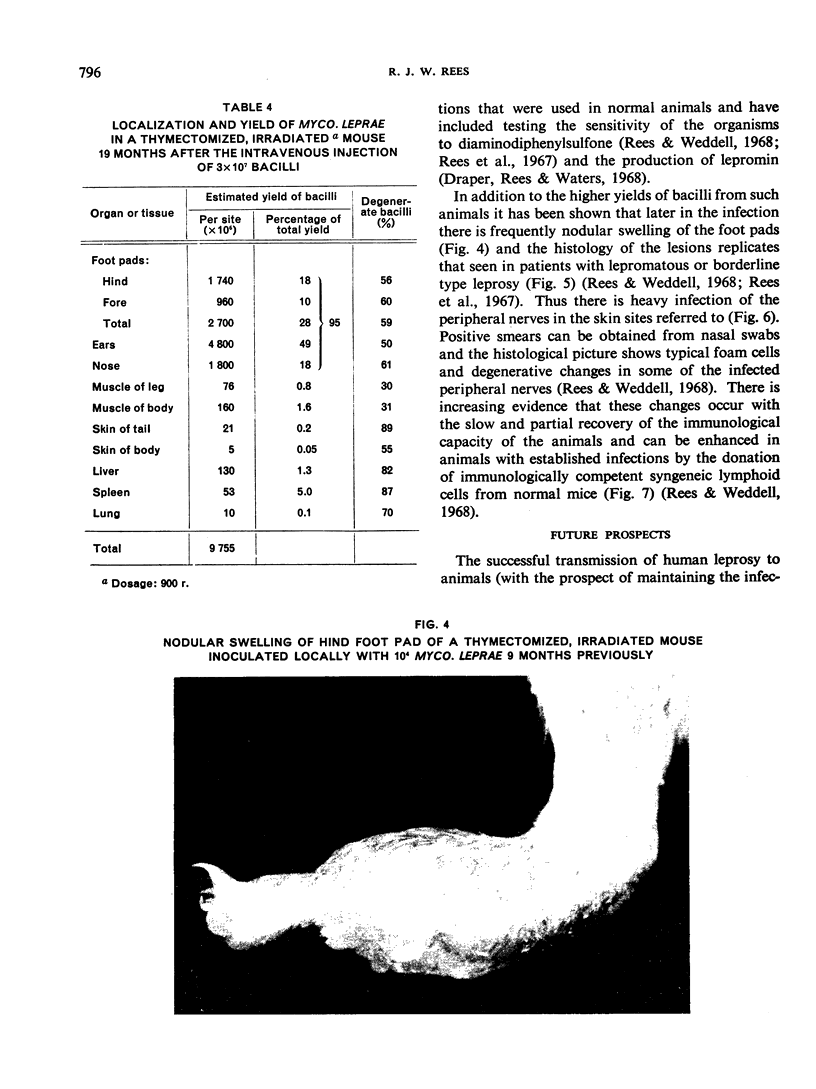
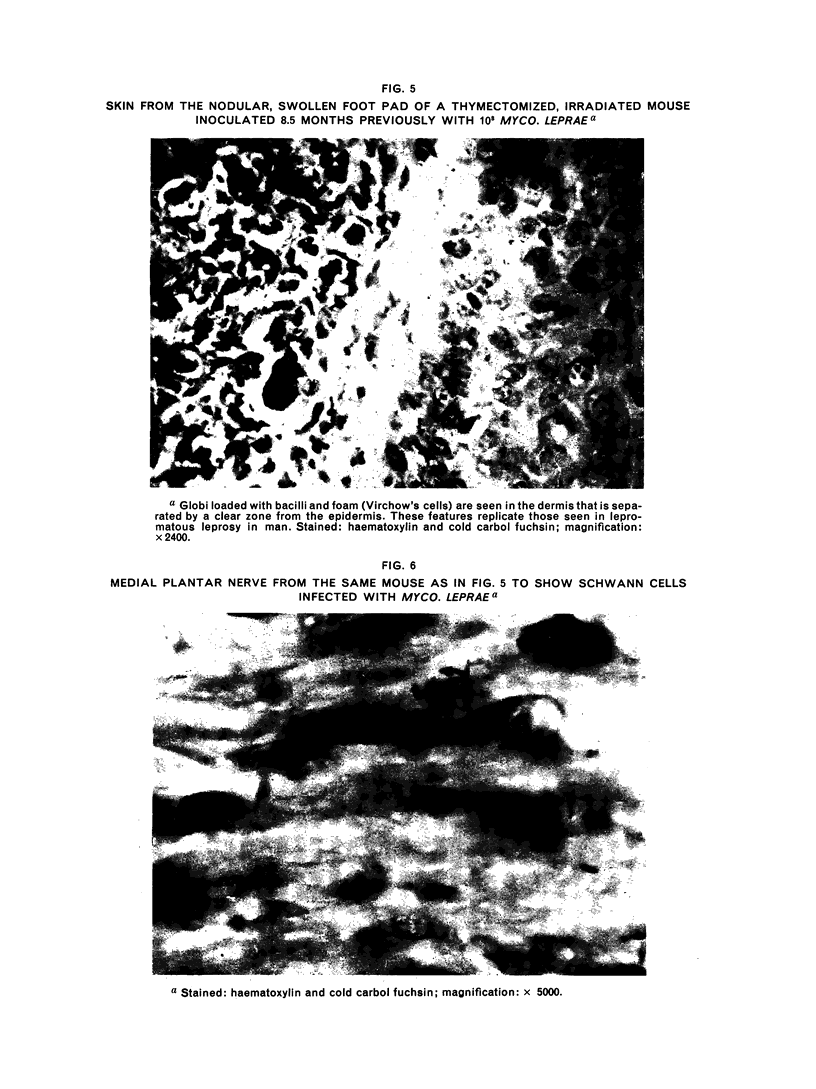
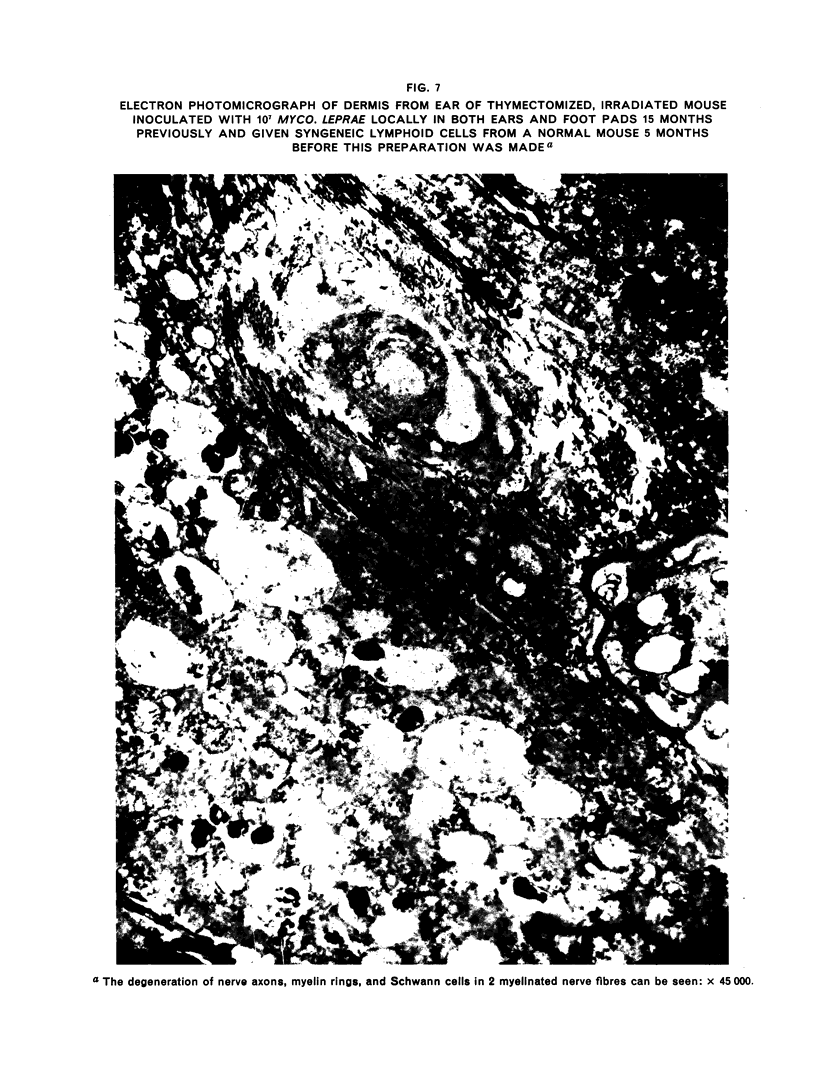
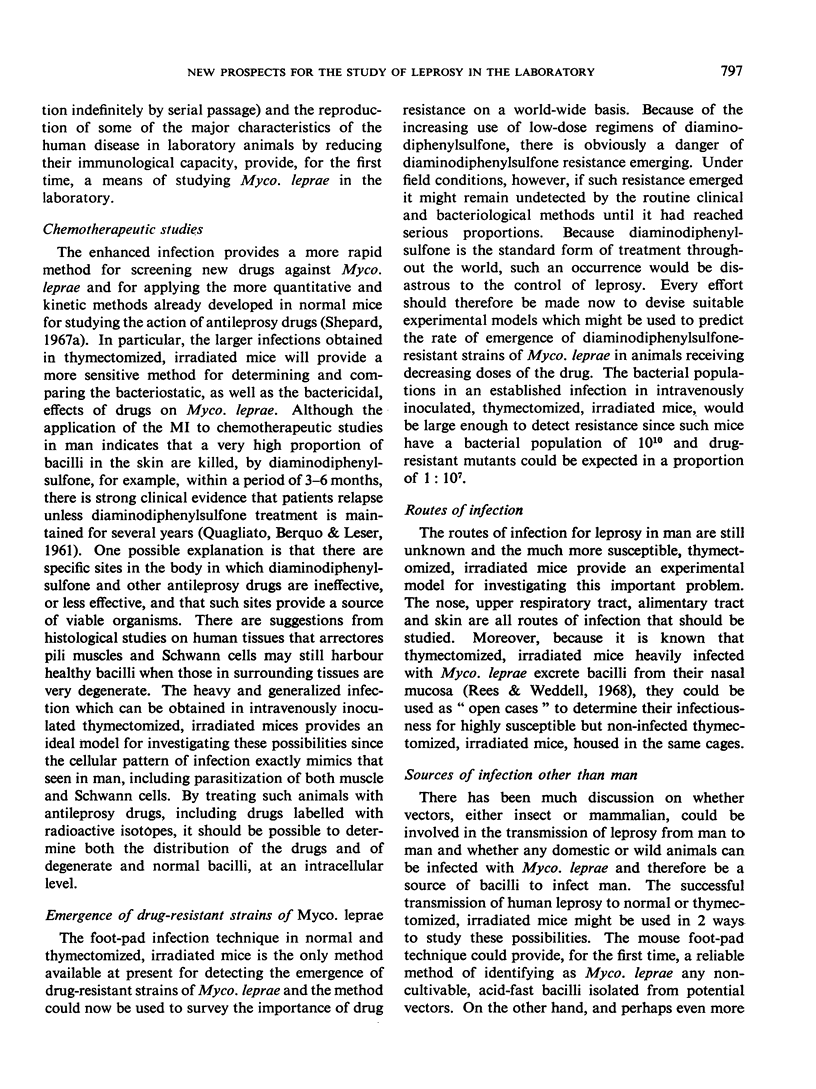
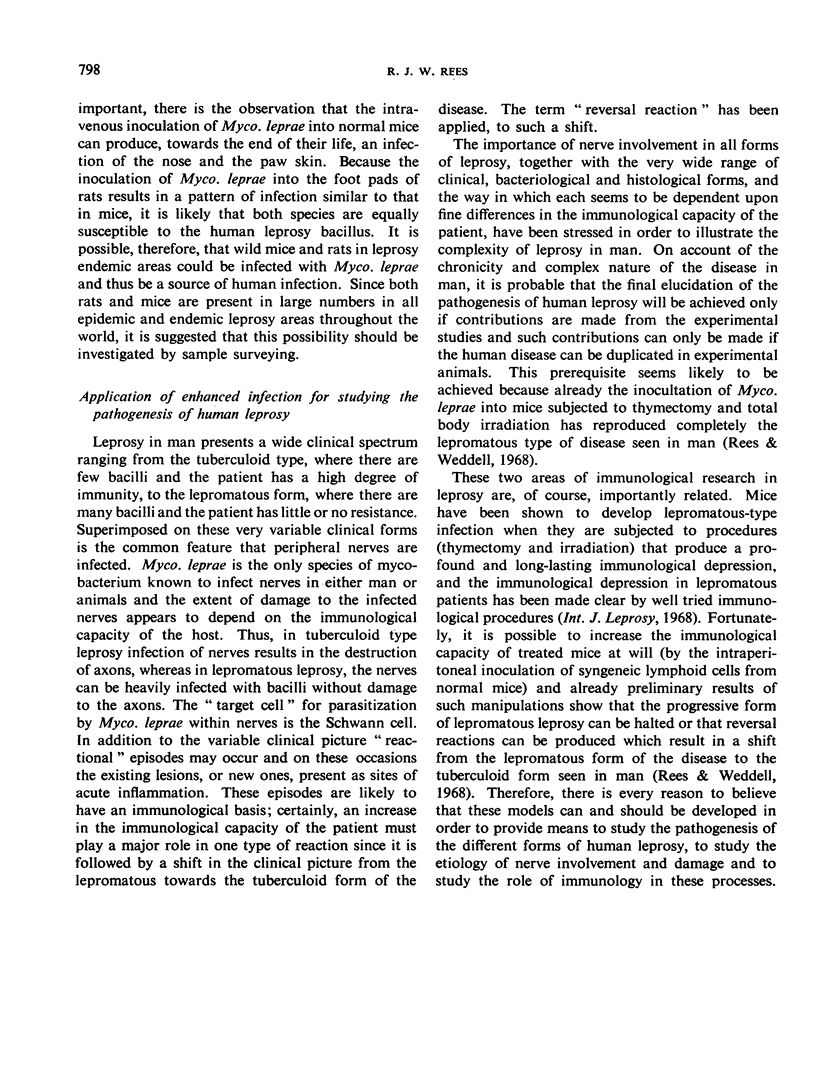
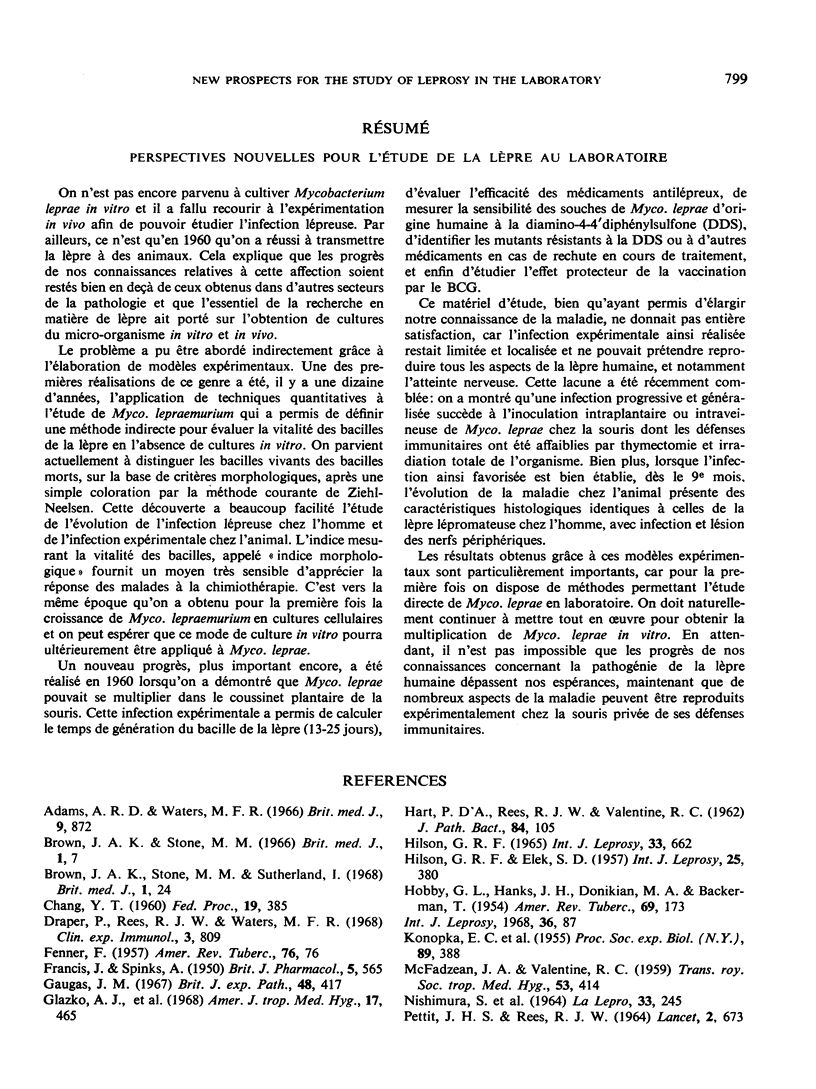
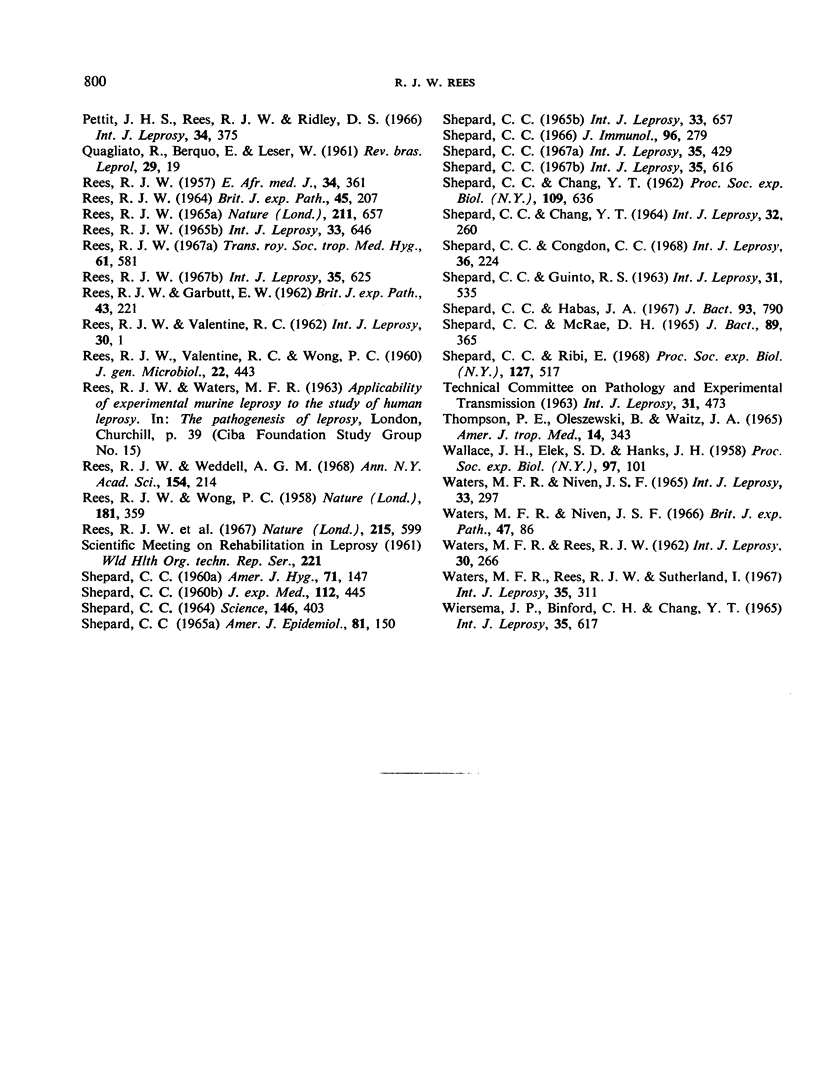
Images in this article
Selected References
These references are in PubMed. This may not be the complete list of references from this article.
- Adams A. R., Waters M. F. Dapsone-resistant lepromatous leprosy in England. Br Med J. 1966 Oct 8;2(5518):872–872. doi: 10.1136/bmj.2.5518.872. [DOI] [PMC free article] [PubMed] [Google Scholar]
- Brown J. A., Stone M. M. B.C.G. vaccination of children against leprosy: first results of a trial in Uganda. Br Med J. 1966 Jan 1;1(5478):7–14. doi: 10.1136/bmj.1.5478.7. [DOI] [PMC free article] [PubMed] [Google Scholar]
- Brown J. A., Stone M. M., Sutherland I. B.C.G. vaccination of children against leprosy in Uganda: results at end of second follow-up. Br Med J. 1968 Jan 6;1(5583):24–27. doi: 10.1136/bmj.1.5583.24. [DOI] [PMC free article] [PubMed] [Google Scholar]
- Draper P., Rees R. J., Waters M. F. Comparison in man of lepromins prepared from leprosy infections in man and mice. Clin Exp Immunol. 1968 Oct;3(8):809–816. [PMC free article] [PubMed] [Google Scholar]
- FENNER F. Homologous and heterologous immunity in infections of mice with Mycobacterium ulcerans and Mycobacterium balnei. Am Rev Tuberc. 1957 Jul;76(1):76–89. doi: 10.1164/artpd.1957.76.1.76. [DOI] [PubMed] [Google Scholar]
- FRANCIS J., SPINKS A. Antibacterial action and metabolism of five sulphones. Br J Pharmacol Chemother. 1950 Dec;5(4):565–583. doi: 10.1111/j.1476-5381.1950.tb00608.x. [DOI] [PMC free article] [PubMed] [Google Scholar]
- Gaugas J. M. Effect of x-irradiation and thymectomy on the development of Mycobacterium leprae infection in mice. Br J Exp Pathol. 1967 Aug;48(4):417–422. [PMC free article] [PubMed] [Google Scholar]
- Glazko A. J., Dill W. A., Montalbo R. G., Holmes E. L. A new analytical procedure for dapsone. Application to blood-level and urinary-excretion studies in normal men. Am J Trop Med Hyg. 1968 May;17(3):465–473. [PubMed] [Google Scholar]
- HART P. D., REES R. J., VALENTINE R. C. Isoniazid resistant and dependent strains of Mycobacterium lepraemurium studied in vivo and vitro. J Pathol Bacteriol. 1962 Jul;84:105–111. doi: 10.1002/path.1700840112. [DOI] [PubMed] [Google Scholar]
- HILSON G. R., ELEK S. D. Intratesticular multiplication of Mycobacterium leprae murium in normal and suramin-treated animals. Int J Lepr. 1957 Oct-Dec;25(4 Pt 1):380–391. [PubMed] [Google Scholar]
- HOBBY G. L., HANKS J. H., DONIKIAN M. A., BACKERMAN T. An evaluation of chemotherapeutic agents in the control of experimental infections due to Mycobacterium leprae murium. Am Rev Tuberc. 1954 Feb;69(2):173–191. doi: 10.1164/art.1954.69.2.173. [DOI] [PubMed] [Google Scholar]
- Hilson G. R. Observations on the inoculation of M. leprae in the foot pad of the white rat. Int J Lepr. 1965 Jul-Sep;33(3 Suppl):662–666. [PubMed] [Google Scholar]
- KONOPKA E. A., GISI T., EISMAN P. C., MAYER R. L. Antituberculosis activity of substituted thioureas. IV. Studies with 4-butoxy-4'-dimethylaminothiocarbanilide (Su 1906). Proc Soc Exp Biol Med. 1955 Jul;89(3):388–391. doi: 10.3181/00379727-89-21819. [DOI] [PubMed] [Google Scholar]
- PETTIT J. H., REES R. J. SULPHONE RESISTANCE IN LEPROSY. AN EXPERIMENTAL AND CLINICAL STUDY. Lancet. 1964 Sep 26;2(7361):673–674. doi: 10.1016/s0140-6736(64)92482-1. [DOI] [PubMed] [Google Scholar]
- Pettit J. H., Rees R. J., Ridley D. S. Studies on sulfone resistance in leprosy. I. Detection of cases. Int J Lepr Other Mycobact Dis. 1966 Oct-Dec;34(4):375–390. [PubMed] [Google Scholar]
- QUAGLIATO R., BERQUO E., LESER W. [Lepromatous patients during sulfone therapy. 1. Bacterioscopic reactivations. 2. Duration of therapy before obtaining negative test results]. Rev Bras Leprol. 1961 Mar;29:19–30. [PubMed] [Google Scholar]
- REES R. J., GARBUTT E. W. Studies on Mycobacterium lepraemurium in tissue culture. I. Multiplication and growth characteristics in cultures of rat fibroblasts. Br J Exp Pathol. 1962;43:221–235. [PMC free article] [PubMed] [Google Scholar]
- REES R. J. LIMITED MULTIPLICATION OF ACID-FAST BACILLI IN THE FOOT-PADS OF MICE INOCULATED WITH MYCOBACTERIUM LEPRAE. Br J Exp Pathol. 1964 Apr;45:207–218. [PMC free article] [PubMed] [Google Scholar]
- REES R. J. Some experimental approaches to leprosy. East Afr Med J. 1957 Jul;34(7):361–362. [PubMed] [Google Scholar]
- REES R. J., VALENTINE R. C. The appearance of dead leprosy bacilli by light and electron microscopy. Int J Lepr. 1962 Jan-Mar;30:1–9. [PubMed] [Google Scholar]
- REES R. J., VALENTINE R. C., WONG P. C. Application of quantitative electron microscopy to the study of Mycobacterium lepraemurium and M. leprae. J Gen Microbiol. 1960 Apr;22:443–457. doi: 10.1099/00221287-22-2-443. [DOI] [PubMed] [Google Scholar]
- REES R. J., WONG P. C. Limited multiplication of M. lepraemurium in tissue culture. Nature. 1958 Feb 1;181(4605):359–360. doi: 10.1038/181359b0. [DOI] [PubMed] [Google Scholar]
- Rees R. J. Enhanced susceptibility of thymectomized and irradiated mice to infection with Mycobacterium leprae. Nature. 1966 Aug 6;211(5049):657–658. doi: 10.1038/211657a0. [DOI] [PubMed] [Google Scholar]
- Rees R. J. Leprosy. A preliminary review of the experimental evaluation of drugs for the treatment of leprosy. Trans R Soc Trop Med Hyg. 1967;61(4):581–595. doi: 10.1016/0035-9203(67)90111-3. [DOI] [PubMed] [Google Scholar]
- Rees R. J. Recent bacteriologic, immunologic and pathologic studies on experimental human leprosy in the mouse foot pad. Int J Lepr. 1965 Jul-Sep;33(3 Suppl):646–657. [PubMed] [Google Scholar]
- Rees R. J., Waters M. F., Weddell A. G., Palmer E. Experimental lepromatous leprosy. Nature. 1967 Aug 5;215(5101):599–602. doi: 10.1038/215599a0. [DOI] [PubMed] [Google Scholar]
- Rees R. J., Weddell A. G. Biology of the mycobacterioses. Experimental models for studying leprosy. Ann N Y Acad Sci. 1968 Sep 5;154(1):214–236. doi: 10.1111/j.1749-6632.1968.tb16711.x. [DOI] [PubMed] [Google Scholar]
- SHEPARD C. C. Acid-fast bacilli in nasal excretions in leprosy, and results of inoculation of mice. Am J Hyg. 1960 Mar;71:147–157. doi: 10.1093/oxfordjournals.aje.a120098. [DOI] [PubMed] [Google Scholar]
- SHEPARD C. C. CAPREOMYCIN: ACTIVITY AGAINST EXPERIMENTAL INFECTION WITH MYCOBACTERIUM LEPRAE. Science. 1964 Oct 16;146(3642):403–404. doi: 10.1126/science.146.3642.403. [DOI] [PubMed] [Google Scholar]
- SHEPARD C. C., CHANG Y. T. ACTIVITY OF ANTITUBERCULOSIS DRUGS AGAINST MYCOBACTERIUM LEPRAE. Int J Lepr. 1964 Jul-Sep;32:260–271. [PubMed] [Google Scholar]
- SHEPARD C. C., CHANG Y. T. Effect of several anti-leprosy drugs on multiplication of human leprosy bacilli in footpads of mice. Proc Soc Exp Biol Med. 1962 Mar;109:636–638. doi: 10.3181/00379727-109-27293. [DOI] [PubMed] [Google Scholar]
- SHEPARD C. C., MCRAE D. H. MYCOBACTERIUM LEPRAE IN MICE: MINIMAL INFECTIOUS DOSE, RELATIONSHIP BETWEEN STAINING QUALITY AND INFECTIVITY, AND EFFECT OF CORTISONE. J Bacteriol. 1965 Feb;89:365–372. doi: 10.1128/jb.89.2.365-372.1965. [DOI] [PMC free article] [PubMed] [Google Scholar]
- SHEPARD C. C. VACCINATION AGAINST EXPERIMENTAL INFECTION WITH MYCOBACTERIUM LEPRAE. Am J Epidemiol. 1965 Mar;81:150–163. doi: 10.1093/oxfordjournals.aje.a120504. [DOI] [PubMed] [Google Scholar]
- Shepard C. C., Congdon C. C. Increased growth of Mycobacterium leprae in thymectomized-irradiated mice after foot pad inoculation. Int J Lepr Other Mycobact Dis. 1968 Apr-Jun;36(2):224–227. [PubMed] [Google Scholar]
- Shepard C. C. Considerations of the application of the foot pad technic in leprosy research. Int J Lepr. 1965 Jul-Sep;33(3 Suppl):657–661. [PubMed] [Google Scholar]
- Shepard C. C., Habas J. A. Relation of infection to tissue temperature in mice infected with Mycobacterium marinum and Mycobacterium leprae. J Bacteriol. 1967 Mar;93(3):790–796. doi: 10.1128/jb.93.3.790-796.1967. [DOI] [PMC free article] [PubMed] [Google Scholar]
- Shepard C. C., Ribi E. Cell walls from Mycobacterium tuberculosis (BCG) as vaccine against Mycobacterium leprae infections in mice. Proc Soc Exp Biol Med. 1968 Feb;127(2):517–521. doi: 10.3181/00379727-127-32729. [DOI] [PubMed] [Google Scholar]
- Shepard C. C. THE EXPERIMENTAL DISEASE THAT FOLLOWS THE INJECTION OF HUMAN LEPROSY BACILLI INTO FOOT-PADS OF MICE. J Exp Med. 1960 Sep 1;112(3):445–454. doi: 10.1084/jem.112.3.445. [DOI] [PMC free article] [PubMed] [Google Scholar]
- Shepard C. C. Vaccination against human leprosy bacillus infections of mice: protection by BCG given during the incubation period. J Immunol. 1966 Feb;96(2):279–283. [PubMed] [Google Scholar]
- THOMPSON P. E., OLSZEWSKI B., WAITZ J. A. LABORATORY STUDIES ON THE REPOSITORY ANTIMALARIAL ACTIVITY OF 4,4'-DIACETYLAMINODIPHENYLSULFONE, ALONE AND MIXED WITH CYCLOGUANIL PAMOATE (CI-501). Am J Trop Med Hyg. 1965 May;14:343–353. doi: 10.4269/ajtmh.1965.14.343. [DOI] [PubMed] [Google Scholar]
- WALLACE J. H., ELEK S. D., HANKS J. H. [Limited multiplication of Mycobacterium lepraemurium in cell cultures]. Proc Soc Exp Biol Med. 1958 Jan;97(1):101–104. doi: 10.3181/00379727-97-23657. [DOI] [PubMed] [Google Scholar]
- WATERS M. F., REES R. J. Changes in the morphology of Mycobacterium leprae in patients under treatment. Int J Lepr. 1962 Jul-Sep;30:266–277. [PubMed] [Google Scholar]
- Waters M. F., Niven J. S. Experimental infection of the ear and foot pad of the golden hamster with Mycobacterium leprae. Br J Exp Pathol. 1966 Feb;47(1):86–92. [PMC free article] [PubMed] [Google Scholar]
- Waters M. F., Niven J. S. Experimental infection of the golden hamster with Mycobacterium leprae. Int J Lepr. 1965 Jul-Sep;33(3):297–315. [PubMed] [Google Scholar]
- Waters M. F., Rees R. J., Sutherland I. Chemotherapeutic trials in leprosy. 5. A study of methods used in clinical trials in lepromatous leprosy. Int J Lepr Other Mycobact Dis. 1967 Jul-Sep;35(3):311–335. [PubMed] [Google Scholar]
- Wiersema J. P., Binford C. H., Chang Y. T. Nerve involvement. Comparison of experimental infections by Mycobacterium leprae and Mycobacterium lepraemurium. Int J Lepr. 1965 Jul-Sep;33(3 Suppl):617–633. [PubMed] [Google Scholar]






